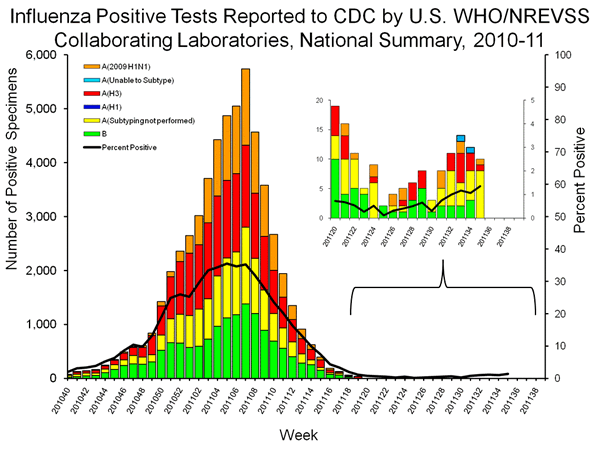

Paradigm Shift Intervention Monitoring
 twitter
twitter

Commentary
H3N2 Dominance
In US
Raises trH3N2 Pandemic Concerns
Recombinomics Commentary 12:45
September 10, 2011

In the past three weeks H3N2 has become the dominant serotype, as represented by the seasonal H3N2 column as well as the unsubtypables, which are clearly trH3N2 isolates which correlate with the reported case from Washington County, Pennsylvania.
As was reported for the delayed reporting of an early trH3N2 isolate from Pennsylvania, A/Pennsylvania/40/2010, trH3N2 isolates frequently subtype as seasonal H3N2 because the H3 and H2 trace back to reasortants involving seasonal H3N2. Thus, the human origin of these genes generates a positive result when assayed by H3 and N2 typing reagents, which target human determinants.
However, the two recent unsubtypables indicate that the 2011 isolates from Pennsylvania fail to type, leading to a sub-typing profile of influenza A positive but H3 and H1 negative for trH3N2, similar to results for pandemic H1N1, which has a swine H1 and N1. Thus, the recent evolution of H3 has moved the trH3 away from recognition by human H3 reagents, but other isolates, like A/Pennsylvania/40/2010 will return a seasonal H3N2 result. Thus, many of the recently reported seasonal H3N2 isolates may be trH3N2.
These newly reported H3N2 isolates, as well as those that are influenza A positive, should be PCR tested, which is also true for early H3N2 isolates, including the large number of unsubtypables reported by Pennsylvania in the 2010/2011 season.
More detail on the recent H3N2 isolates classified as seasonal H3N2 would be useful.
Recombinomics
Presentations
Recombinomics
Publications
Recombinomics
Paper
at Nature Precedings